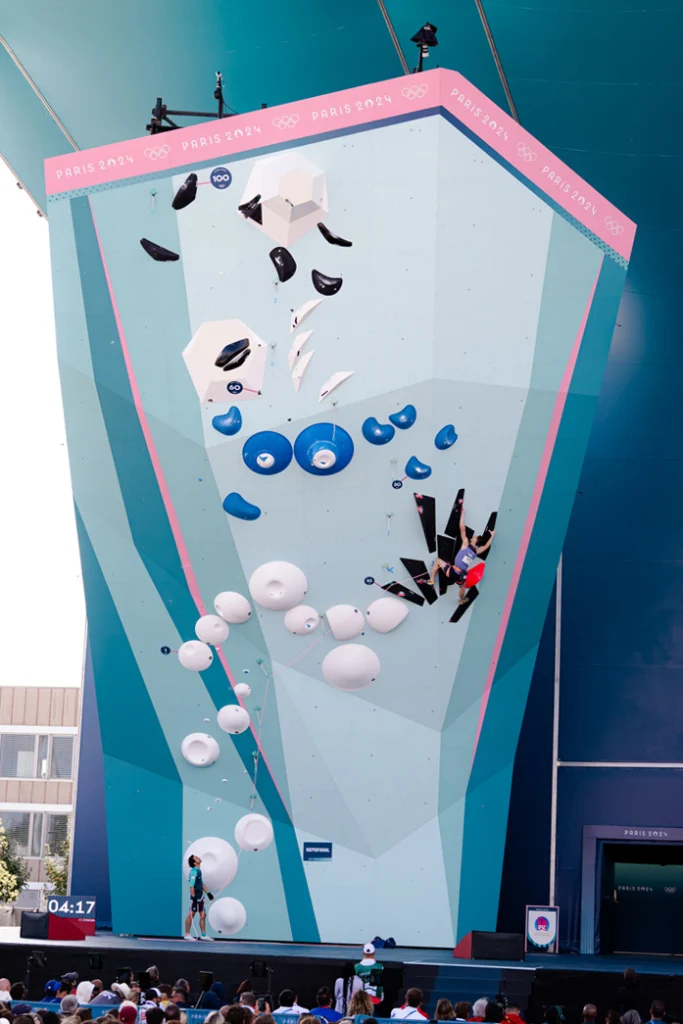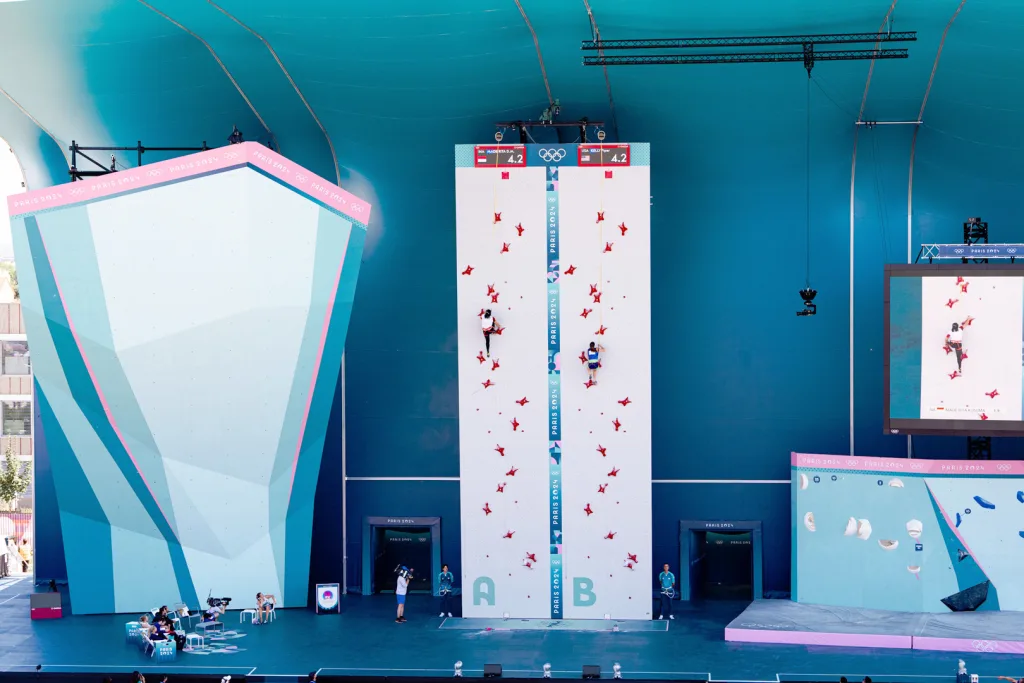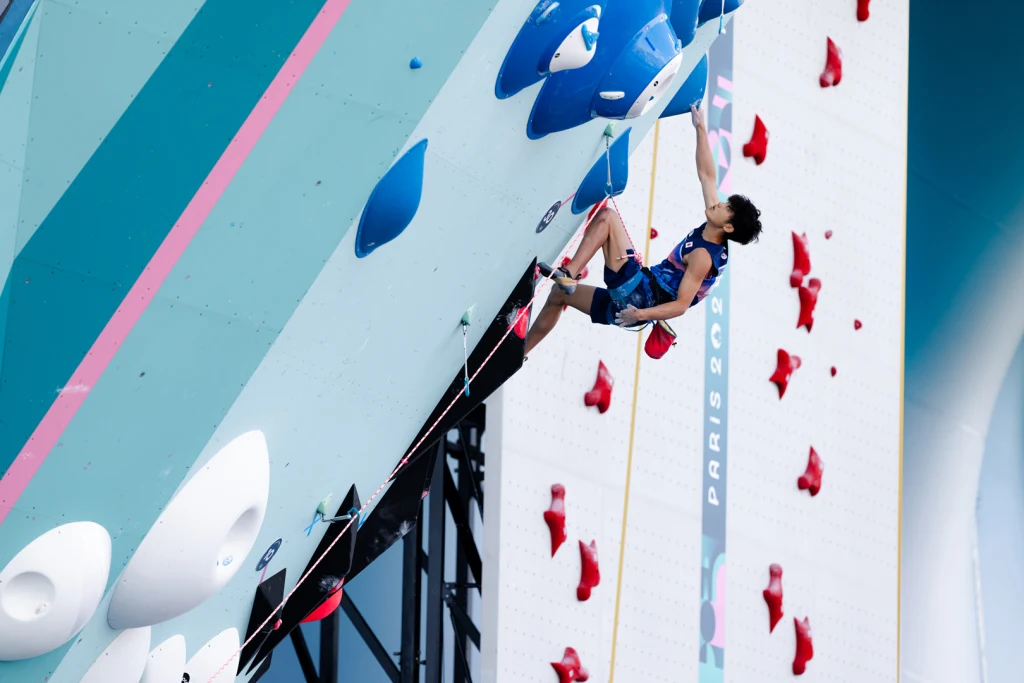Most of us have seen enough basketball courts, lap pools, and race tracks to know how athletes are supposed to move on each surface. But what about a gravity-defying boulder? Having made its debut at Tokyo 2020, sports climbing is a relatively new kid on the Olympic block. But it is back at the Paris Olympics with an even wilder boulder (for better or worse named Titan). Titan is a near 15-foot tall wall covered with jagged, colorful shapes that are scattered across the surface in four different, yet equally dizzying patterns.

It only takes one look at this boulder for an average person to ask: How on earth is an athlete supposed to grasp onto a miniature, one-inch grip, swing their entire body onto a slippery triangle, then hoist themselves onto a semi-sphere? The team that decides how to arrange the shapes on the boulder is experienced enough to know the answer to that question, but they also know that the average person does not. “Part of our goal is to create a spectacle and a memorable experience so people want to see climbing again and again,” says Garrett Gregor, who is the head routesetter for the Titan boulder at the Paris Olympics.

A routesetter’s job is to design (and test) climbing routes, which are called problems, in a way that makes it possible—but extremely difficult—to reach the top of the boulder in your allocated time. A good route, according to Gregor, is one that gets progressively difficult and one that encourages climbers to think critically and problem solve in real time, which may be why a large number of professional climbers, Gregor included, are engineers by background. (When Gregor started climbing in 2000, there was no such thing as a professional routesetter; now, he is certified with USA Climbing.)

Designing routes is a collaborative and “fluid” process with “no fixed mathematical equation for what needs to happen and when,” says Gregor. He notes there have been efforts to modernize the process with software that helps you visualize the route, but so far, none of those have come to fruition, and most routesetters end up experimenting on-site.

This year’s sports climbing event consists of three disciplines: Bouldering, which happens on the Titan and requires climbers to scale four separate routes in four minutes; Lead, in which climbers use safety ropes to rise as high as possible within six minutes, and Speed, where athletes are scored based on how fast they can climb a 49-foot wall.

All three walls coexist on the same stage, but if you’re watching with the eye of a designer, the bouldering wall is by far the star of the event. The Titan was designed and built by climbing manufacturer EP Climbing in collaboration with the International Federation of Sport Climbing. It is the first standard bouldering competition wall, meaning that gyms around the world can (and already have) buy the exact same wall and lure amateur climbers desperate to improve their skills into a membership with the promise of an Olympian wall.
No matter how intimidating that wall might be, however, it is only a backdrop pierced with holes. What truly determines the difficulty of a climb is the way the various shapes—called holds, macros and volumes depending on their size and function—are plugged into these holes.

If you see a body contorted in ways you never imagined, it isn’t just because routesetters have arranged these shapes in ways that will challenge the athletes. It’s also because they are trying to entertain the audience by predicting the kinds of movements they will have to perform while holding onto those shapes. This matters because sports climbing, like some of the newer Olympic sports that debuted at Tokyo (think surfing, skateboarding, and breakdancing) are not guaranteed a spot at every Olympic Game. The better the ratings in Paris, the higher the chance for a spot at LA 2028.

This year, for example, I watched some climbers balance their entire weight on a single toe, hoist themselves on three fingers, and practically do the splits on a vertical wall. “This is our opportunity to broadcast our sport to people that don’t know climbing, and creating something that’s going to draw people in is part of what our job is,” says Gregor. “At same time, it’s up to athletes to help put on that show so it’s a symbiotic relationship.”

If Competition Climbing Reddit is any indication, the team may have gotten a bit carried away with the level of difficulty this year, as very few athletes (particularly in the men’s category) have been able to finish some of the routes. This has resulted in a “frustrating,” or “boring” event for some, but only time will tell if the broader audience disagrees.
You can see for yourself: the men’s final is set for today, and the women’s final is tomorrow. And if the thought ever crosses your mind that you can rival these Olympians… think again.